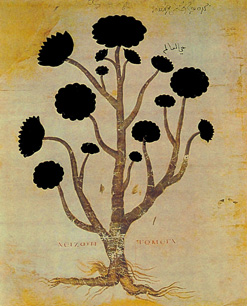Shadowflower Ink

The portion of the “shadowflower” (Aeonium arboreum ssp. umbra) commonly seen as a flower is not a true flower. Although its black “petals” indeed form beautiful floral patterns, they are in fact leaves. (It is a flowering plant, but the flowers themselves aren’t subspecies-specific.) The shadowflower’s leaves are this deep a black because the flower grows in dark places, and must absorb every drop of light it gets. However, when touched, it attempts to blend into its environment. How does it do this? Shadowflower leaves have not only a color but also a meta-color: They are the color of desire.
Specifically, it is the color that the user wishes. Shadowflowers themselves, simple creatures that they are, thirst for light and safety. When safe, they turn deep black, to absorb as much light as possible. When unsafe (as indicated by touch), their colors match their surroundings, providing marginally more safety.
However, rather unfortunately for the flowers themselves, this persists when the ink was harvested. Fortunately for the flowers, most people consider this a minor curiosity, given that the color only changes when wet. Attempts were made to use it for military camouflage, but as the mutability did not on dry cloth, this was little more effective than other camouflage-production techniques. Early on, all that it meant was this: The price of shadowflower ink was an upper bound on how much you could charge for any ink noteworthy for color alone. (It wasn’t a very low upper bound. The plants themselves needed to be grown either in warm, dry climates or in greenhouses, and they didn’t produce very much ink when processed.)
In this more modern era, some high-end printers included reinforcement-learning agents, taught to yearn for the colors they were told, making it possible to print millions of shades of color with one ink cartridge. Images printed in this manner seemed to be better, in some indiscernible way, when the people near the printer cared more about the image. Preference utilitarians, concerned at first for the well-being of insects, were immensely pleased when only beings with brains, RL agents, and shadowflowers themselves could change the color of a shadowflower ink droplet’s contents.
The ink was only the color of desire when wet. Eventually, after people crying onto printouts of now-traitorous companions noticed the images morphing into pictures of the apologetic or dead forms of their new rivals, a fixative was developed to protect re-wetted images. Shadowflower ink was expensive, and people didn’t want to rewrite a photo with a few tears.
It was amazing to me that nobody had seen the potential in this. It was possible to acquire images of unfulfilled but very much desired scenarios? I purchased some pre-fixative-development tear-contaminated printouts, for close inspection. What I found, regardless of how tragic it had been to the original owners, had delighted me.
Again because shadowflower ink was expensive, the owners of even these damaged images expected me to pay prices in the tens of dollars for them. I bought the most promising one, first, and eagerly opened the envelope when it arrived. Tears had soaked through a wedding photo, replacing it with a newspaper obituary about the husband dying of an STD he’d acquired from his new girlfriend. The obituary itself was rather uncreative, mockingly describing an incident of unfaithfulness kicking off a truly ridiculous number of catastrophes in the husband’s life.
I didn’t actually care: this hopefully wasn’t the interesting part. I looked at the rest of the newspaper that I could see. Above the obituary was the end of an op-ed about the new fire prevention municipal ballot measure that had been rejected a few years ago. Sure enough, the local Herald had the text of that article on their website … with a publication date several months after the damage to the photo occurred. Even more interestingly, the shadowflower-generated version of the article contained a joke about the measure that the real article had never made.
Well, then. I had my existence proof. It was now time to buy ink and paper. I wasn’t going to replace this cell phone very soon after all, it seemed. Unless my plan worked… I cut myself off. That hope was to be preserved, and used after purchasing.
I took the paper in my hand and begin to coat it with a thin layer of ink. I knew what I wanted. Although some Buddhists use meditation to rid themselves of desire, the art is still quite useful to those instead wishing to cultivate it. You write and erase with the same pencil, after all. I focused intensely.
Someday, I hoped to lead immortal humans to the stars. And once I did that, I would write down the instructions on how I could do it again onto two large panels in my palace, and stand and gaze on them, with the panels separated just enough that someone standing behind me would be able to read all of the text.
And that was what I desired. I looked at the paper, with this hope and this hope alone filling my heart. The black rectangle I’d painted onto the paper began to take on other colors.
“1. Research the …”
(Inspired by Sepiida Secrets. Image modified from source here.)
